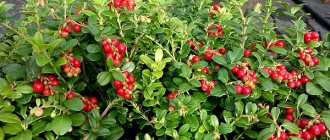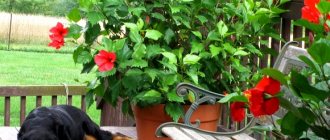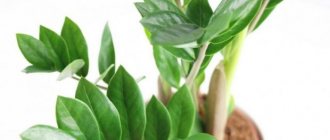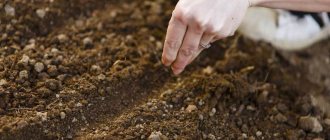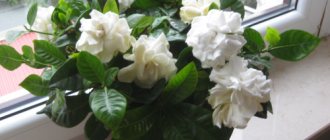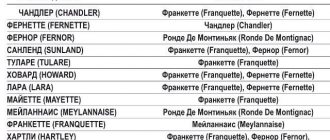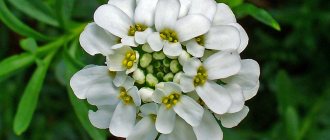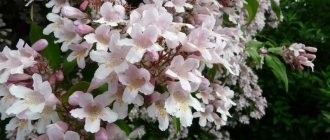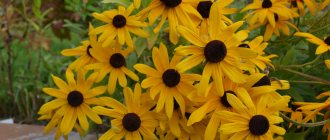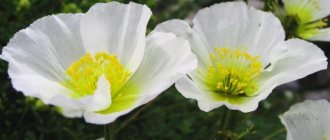Lingonberry (Vaccinium vitis-idaea) is a berry-bearing evergreen shrub. This species is a representative of the genus Vaccinium; in nature it is distributed in tundra and forest zones. This shrub prefers to grow in mixed, coniferous and deciduous forests, peat bogs, mountain and lowland tundras. Lingonberry is found in Western Europe, Northern Mongolia, North Korea, European Russia, East Asia and Manchuria. The name of the species is translated from Latin as “grapevine from Mount Ida” - this place is located on the island of Crete. The first mention of the genus name was found in sources of the 16th century, and lingonberries began to be cultivated more than a century ago in America. Around the same time, the first appearance of varieties of this crop occurred. In Europe, this plant began to be cultivated only in the sixties of the last century. Today, in Lithuania, Russia, Belarus and Germany, medicinal or common lingonberries are grown on an industrial scale. Not so long ago, lingonberries began to be grown on an industrial scale in Scandinavian countries.
Features of lingonberries
Garden lingonberry is a low-growing shrub, the height of which varies from 2.5 to 25 centimeters. The cord-like rhizome is colored brown-green and reaches a length of 18 centimeters; it rarely has short and thin roots, which lie at a depth of only 20–100 mm. On the stems extending from the rhizome there are small, hairy, light-colored branches. Leathery perennial leaf plates of elliptical shape with a rolled edge reach a length of 5 to 7 centimeters and a width of 3–12 centimeters. The alternate leaves have short, pubescent petioles. The front surface of the leaves is dark green, and the underside is lighter in color and has dark brown glands. The lush, drooping racemose inflorescence, growing at the tips of last year's branches, consists of 2-8 bell-shaped flowers of a pinkish color, their calyx is jagged, and the pedicels are pubescent in a pale red color. Those flowers that grow in the upper part of the shoot are 1.5–2 times smaller than those located at its base. As a rule, bumblebees and bees participate in the pollination of this shrub. The fruit is a multi-seeded berry of deep red color and almost spherical shape, it reaches 1.2 cm in diameter. Flowering of such a crop is observed in May–June, and fruiting occurs in the last weeks of summer or the first weeks of autumn. Often, the same bush contains both fruits and flowers at the same time. Relatives of this plant are the following crops: blueberries, blueberries and cranberries. Cranberries and lingonberries are very similar to each other, however, lingonberries have denser fruits, not so large and not very sour.
Lingonberries on 6 acres. Garden world website
What is lingonberry
Most Russians know where the healthy lingonberry (Vaccinium vitis-idaea) grows.
She lives in forests: from gloomy conifers to cheerful deciduous shards. Where lingonberries grow in Russia, it is entirely tundra and peat bogs - this is its favorite refuge. The distribution area of the small shrub covers Siberia, the Far East and Central regions, including Murmansk and Arkhangelsk. Vologda. The wild plant forms evergreen, subshrub, branching forms that grow to a maximum of 10-20 cm. The bushes bloom with white and pink bell-shaped flowers collected in brushes. The hard, dark green, glossy petiolate leaves contrast with the small, deep red berry. People observe what lingonberries look like and how elegant the clearings with the tart-sour-tasting berry are in the fall (August-September) during the fruit harvest.
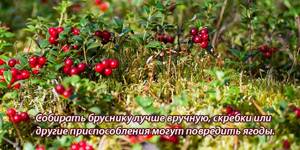
Wild lingonberries in forests and garden lingonberries differ in the size of the bush and the taste of the berries, but the chemical composition and beneficial properties are fully preserved. Thanks to breeding work, Vaccinium vitis-idaea can now be grown in your garden plots, but special conditions are needed for its growth. Which berry to prefer is decided by the lover of fruit drinks or liqueurs made from tart fruits.
Although lingonberry is a subshrub, it has an enviable life expectancy. Clumps collected from shrubs and connected by a common rhizome live from 100 to 300 years. Fruiting begins when the plant reaches 15 years of age.
Planting lingonberries in open ground

Lingonberries have one feature - they are completely undemanding to the soil. Any sunny area with a flat surface is perfect for growing it. If the site is uneven, then stagnation of water and cold air is observed in the hollows and depressions, and this negatively affects the growth and development of this crop. The shrub is undemanding in terms of soil composition; it can be grown on loamy, peat-sandy, sandy loam and peaty soil, which has high acidity (pH 3.5-5.5). In order for lingonberries to grow well and bear fruit well, it is necessary to create soil on the site that meets all the requirements of this crop. To do this, you need to remove a layer of soil, the thickness of which should be 0.25 m. The resulting depression must be filled to the top with a mixture consisting of sand and any peat, or high-moor peat. You should also add loose pine needles, sawdust or tree bark to the recess. Then the surface of the area must be compacted and spilled with acidified water (1 bucket per 1 square meter). You can use a variety of acidifiers: acetic or malic acid (9%) (100 milligrams per 1 bucket of water), and you can also take oxalic or citric acid (1 small spoon per 3 liters of water).
For planting, annual or biennial seedlings are used. They are planted according to a 0.3x0.4 m pattern, and the plant only needs to be buried 20 mm into the soil. If lingonberries are grown as an ornamental plant, then when planting the bushes can be positioned, keeping a distance of 0.2 m between them. After the lingonberries begin to actively grow, the crowns of the bushes will close together, resulting in a continuous, spectacular covering. When the plant is planted, the surface of the soil must be compacted, and then watered. When the liquid is absorbed into the soil, its surface needs to be mulched; for this, straw, pine needles, tree bark, sawdust or sand are used. You can also use gravel as mulch, but it is best to use sawdust or wood shavings. The mulch should be laid in a layer five centimeters thick.
Blueberries and lingonberries, planting and care // FORUMHOUSE
Cowberry propagation
It's easy to propagate lingonberries. There are as many as 4 available methods - 3 vegetative and 1 seed, each of which will be considered separately.
Propagation by stem cuttings
- In early spring, before the start of sap flow, or in late autumn, cuttings of at least 5 cm in length are cut using pruning shears.
- A soil mixture is prepared from 2 parts peat and 1 part sand. The mixed soil is poured into containers and moistened.
- Before planting, the cuttings are soaked for several hours in a solution of a growth stimulator (you can do without this).
- The lower cut of the cuttings is immersed in the substrate, leaving at least 2–3 buds above the surface.
- To maintain high humidity, containers with cuttings are covered with a bag, creating a greenhouse microclimate inside with an air temperature of +25°C.
- The plantings are periodically ventilated and sprinkled with water.
- During the growing season, the cuttings acquire a root system. The following year they are safely relocated to a permanent place.
Video: how to properly cut lingonberries
Propagation by root cuttings
The procedure is carried out only if the area of the rhizome has growth buds or shoots. This lingonberry propagation method is suitable for late April or early May.
- In order for rooting to be successful, prepare a bed, which is filled with a substrate of sand and peat in proportions 1:3 or 1:2.
- Ten-centimeter depressions are made in the substrate and the surface is moistened.
- Pieces of rhizome are planted, covered with soil and watered again.
- Wire arches must be installed above the bed and the plantings covered with covering material.
- Water for a month, preventing the substrate from drying out. After rooting, the cover can be removed, but watering must be done regularly. Young plants, which will get stronger by the end of the growing season, are left to overwinter in the garden bed.
- Lingonberries grown from root cuttings will be ready for transplanting to a permanent location in a year or two.
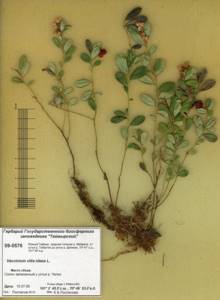
A rhizome with shoots can be divided into parts
Reproduction by partial, or daughter bushes
From the underground rhizomatous shoots - stolons - formed in lingonberries, young plants are formed. They are connected to the mother plant by rhizomes and are called partial bushes. For the purpose of propagation, only bushes that have their own root system are used. Reproduction in this way is possible both in spring and autumn. To do this, young and well-formed bushes are dug up and separated from the mother plant.
- You can plant lingonberry bushes either in a prepared separate bed for growing, or in separate containers.
- Plants grown in containers are ready for transplanting into open ground after a year.
- It is best to plant bushes in the garden bed for further growing in the spring. The plant will have enough time to take root before winter.
- Bushes planted in autumn should be well mulched with peat, spruce branches, or a shelter made of non-woven material should be installed over them.

Partial lingonberry bushes can be planted in separate beds for growing
Seed propagation
This type of propagation is more suitable for non-varietal lingonberries. The process is labor-intensive, but expedient due to the low cost of the resulting material for expanding plantings. Only well-ripened berries are suitable for seed selection. They are kneaded and washed in a small amount of water. The pulp and skin are removed, and the seeds are placed on a sieve, after which they are dried.
Before sowing, the seeds must be prepared. This procedure is called stratification. It can be natural - the seeds are sown in the garden in the fall. Hardened by winter conditions, the seeds germinate in the spring. Or you can collect the seeds and store them for 4 months in damp sand at an average temperature of 4°C, for example, in the lower compartment of the refrigerator.
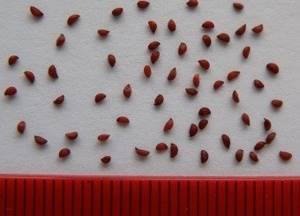
Before sowing, lingonberry seeds must be stratified
Treated seeds show better germination.
- Seeds are sown in containers filled with a mixture of peat and sand. Since the seeds germinate well in the light, there is no need to bury them.
- To maintain high humidity and an average temperature of 20–25 ° C, the container can be covered with a transparent bag or glass and placed in a bright and warm place. But not in direct sunlight!
- The mini-greenhouse is ventilated and the substrate is moistened.
- After the first shoots appear, the cover can be removed after 2–3 weeks.
- When 4 adult leaves appear on the seedlings, they can be planted in separate pots or in a greenhouse bed.
- The seedlings are watered regularly throughout the year, after which they are ready to be transplanted to a permanent location.
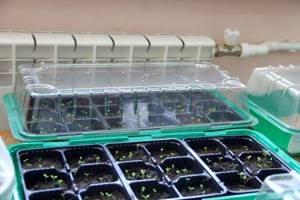
It is very convenient to germinate seeds in mini-greenhouses
How to grow garden lingonberries in a pot
Lingonberries, which are compact in size, can be placed at home if desired - on the windowsill or on the balcony. But it is worth considering the difficulties that may arise:
- Lingonberries have a horizontal and creeping rhizome, which will be cramped in small volumes;
- You will have to strictly control watering, since overdrying and waterlogging of the soil can destroy the plant.
You only need to water lingonberries with rainwater or water that has settled for several days at room temperature.
For planting you need to prepare:
- low but wide flowerpot. The size will depend on the root system of the lingonberry bush. There must be holes at the bottom to allow excess water to drain into the pan;
- drainage is a must;
- substrate - it is better to prepare it yourself. Regular garden or all-purpose soil will not work. The simplest mixture can be obtained by mixing 3 parts of high-moor peat and 1 part of coarse sand;
- planting material. You can buy it at a garden center or dig it up in the forest.
Step by step process:
- Place a good layer of drainage at the bottom of the flowerpot.
- Sprinkle the prepared soil mixture on top.
- Place the bush in the middle of the container and add remaining soil to the sides.
- Lightly compact the soil around the perimeter of the flowerpot and water generously. Be sure to remove any remaining water from the pan.
- Lingonberries should be kept in a bright place, but avoiding drafts. The plant feels very good outdoors. Therefore, if there is a balcony or loggia, you should move the flowerpot there.
Lingonberries in a flowerpot will become a real decoration for a balcony or window sill. Glossy green foliage, which does not fall off even in winter, will delight the eye throughout the year. Blooming lingonberries will allow you to admire miniature flowers collected in tassel bouquets. And ripened coral-red fruits will not only enliven the greens, but will also help diversify the taste sensations if you add them to prepared dishes.
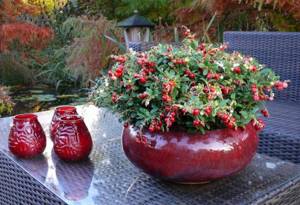
Lingonberries grown in a flowerpot will become a real decoration for a window sill or balcony.
Lingonberry care

Watering
During the entire growing season, this shrub will need systematic watering, which is carried out 2 times every 7 days, with 1 bucket of water per 1 square meter of land. If the weather is damp, watering should be postponed. For lingonberries, it is recommended to organize drip irrigation or drip irrigation, which is carried out in the evening after sunset. An acidifier must be added to the water for irrigation once every 20 days. After the lingonberries have been watered, the next day it is necessary to loosen the surface of the soil between the rows, while removing all the weeds.
Fertilizer
Mineral fertilizers must be applied to the soil under plants with caution, because they can harm the crop. Fertilizing should be done on time, but with caution; in the first couple of years after planting, superphosphate and ammonium sulfate will need to be added to the soil (take 1 small spoon of each fertilizer per 1 square meter). Once every 5 years, the soil is fully enriched with complex fertilizer.
Trimming

Lingonberries require periodic thinning of the thickets; this procedure is carried out after the bushes become excessively dense. In the seventh year of growth, the plant will need anti-aging pruning; for this, all stems need to be shortened to a height of 40 mm. This pruning is carried out in the spring before sap flow begins, or in late autumn, when the entire harvest has been harvested. After just 1 year, lingonberries will begin to produce full harvests.
Pests and diseases
Caterpillars of copperheads and leaf rollers, as well as leaf beetles, can settle on such a bush. These insects can be removed from the plant by collecting it manually, and can also be repelled; for this, the bush is treated with an infusion prepared from onion, dandelion or tobacco peels. If there are a lot of pests, then the bush needs to be treated with Actellik or Ambush. Lingonberries can be affected by a fungal disease, for example, rust, due to which the stems and foliage turn brown and dry out. The affected plant must be sprayed with a solution of pesticides, namely Topsin and Cuprosan. Before you start processing, carefully read the instructions, dosages and precautions.
Wintering
Lingonberry is a northern plant with very high winter hardiness. Therefore, it can withstand very cold winters with little snow. However, during the flowering period in spring, return frosts can harm the bush. If there is a threat of frost, cover the lingonberries with non-woven material, for example, lutrasil.
Cowberry
Lingonberry collection and storage

As a rule, lingonberries are harvested in August and September, after the fruits are fully ripe. Since the berries contain a large amount of benzoic acid, they can be perfectly stored throughout the winter period; for this, they are placed in containers made of ceramic or wood, which are filled with weak sugar syrup or water. Canned or dried fruits last much longer. Frozen berries also store very well. To do this, washed ripe fruits need to be dried and, after distributing them into containers or polyethylene bags, put them in the freezer.
LINGONBERRY - SEARCH, COLLECTION, CLEANING, SUGARING. PREPARATION RECIPE – SÜF KRASNODAR
Why is lingonberry color popular?
Lingonberry color has become one of the most popular and requested colors for interior decoration in 2021. This demand is quite understandable. Berry colors have always attracted attention with their richness and richness. Adding them to a regular interior helps create a spectacular and unique design.

Lingonberry color does not lag behind other berry shades; it is distinguished by its nobility and mystery. It displays some hints of the Victorian era, adding even more luxury. In the new year, this color received incredible publicity and began to appear more and more often in the design solutions of many masters.
Related links: 6 best models of mobile tables
Types and varieties of lingonberries
Today, approximately 20 varieties of lingonberries are known. The most popular are:

- Coral . The compact spherical bush has a height of about 0.3 m and the same crown diameter. During the season, it bears fruit twice (in July and September). This variety, characterized by high yield, was bred by Dutch breeders. The fruits weigh about 0.3 grams and are colored deep red or pink. They have a classic sweet and sour taste.
- Mazovia . The variety was bred in Poland. This low-growing shrub is practically a ground cover; it bears fruit twice a season. The slightly sour fruits weigh about 0.25 grams and are dark red in color.
- Erntesigen . The variety was bred by German breeders. The height of the bush is about 0.4 m, the reddish sweet and sour fruits are relatively large, their diameter can be approximately 10 mm.
- Erntekrone . The height of a medium-sized bush is about 0.2 m. Large dark red fruits weigh about 0.4 grams, the taste is sweet and sour. The ripening of berries is observed 2 times per season.
- Ruby . Late variety. The height of the bush is about 0.18 m. The sweet and sour berries weigh about 0.2 grams and are colored dark red.
- Kostromichka . This variety bears fruit only once per season - in mid-August. Dark red, sweet and sour berries can reach 0.7–0.8 cm in diameter.
- Ida . Dense, spherical bushes reach a height of 0.15 to 0.2 m. The rich red fruits weigh from 0.5 to 0.8 grams and ripen very early. The second harvest of the season ripens in September.
- Sanna . The stems are erect, they have a height of 0.15 to 0.25 m. The red, round berries weigh about 0.4 grams. They ripen in August.
- Kostroma pink . The height of evenly branched bushes can reach 0.25 m. This variety is self-fertile, with an average ripening period. The diameter of the berries is from 0.7 to 0.8 cm, their color is dark red. Fruit ripening is observed in the second ten days of August.
The following lingonberry varieties are also recommended for cultivation: Erntedank, Red Pearl, Suzy (Sussi), Runo Belyavske, Scarlett, Red Emmerland, Linnea, etc.
Characteristics of lingonberries
The presented plant is a shrub that belongs to the Heather family. In order for the berry to retain all the vitamins and bring exceptional benefits to the body, it is important to know where to collect it. This is due to the fact that lingonberries are capable of accumulating radioactive substances, so before you go to harvest, you need to carefully choose a place.
A coniferous or mixed forest remote from the city and production areas is best suited.
The first notes on the cultivation of lingonberries appeared in 1745. Then Empress Elizaveta Petrovna issued a decree in which she demanded to find a way to grow this berry in the vicinity of the city. Truly massive plantations began to grow in the 60s in Germany, Holland, Poland, Belarus, the USA, Sweden, Russia, and Finland.
Appearance
Each berry has a bright red color. They are spherical, shiny, reaching up to 8 mm in diameter. The weight of the fetus ranges from 0.07 g to 0.55 g.
Taste and smell
Lingonberries have a bitter taste and a pronounced sweet and sour note. Benzoic acid is to blame for the bitter taste. It is this that is the best natural preservative. The smell is faint, pleasant, a little reminiscent of the aroma of early fresh honey.
Composition and calorie content
The fruits of this berry boast a large amount of essential oils, polyphenols, and pectin substances. In addition, per 100 grams of product there are:
- 0.7 g proteins;
- 0.5 g fat;
- 9.6 g carbohydrates (of which 8 g mono and disaccharides);
- 1.6 g fiber;
- 1.9 g of organic acids (lactic, tartaric, benzoic, salicylic, citric, malic);
- 0.2 g of ash.

The composition of summer sweets includes the microelement iron. Among the macroelements stands out:
- phosphorus;
- potassium;
- magnesium;
- sodium;
- calcium.
Lingonberries are loved for their vitamin complex:
- vitamin C (ascorbic acid);
- vitamin B1 (thiamine);
- vitamin B2 (riboflavin);
- vitamin A (beta-carotene);
- vitamin PP (niacin).
Per 100 grams of presented berries there are up to 46 kcal.
Properties of lingonberries: harm and benefits
Useful properties of lingonberries

It has been known for a very long time that lingonberry fruits have healing properties. So, it used to be called the “berry of immortality” because it could cure many diseases. The main value of lingonberries is that they contain a large amount of vitamins A, E, B and C. The berries also contain organic acids (citric, malic, oxalic, benzoic and salicylic), minerals such as manganese, magnesium, potassium, iron, calcium and phosphorus, as well as starch, mono- and disaccharides, flavonoids and other substances that the human body needs.
The foliage of this plant is not inferior to its fruits in terms of healing properties. It also contains many useful substances, and the most important of them is arbutin (a natural antiseptic). Today, the fruits are used for medicinal purposes somewhat less frequently than the foliage. The fact is that leaves are much easier to harvest and transport, and they can be stored for a longer time without losing their beneficial properties. The foliage has anthelmintic, wound-healing, antiscorbutic, diuretic, diuretic, restorative, antipyretic, tonic, laxative, choleretic and antiseptic effects.
This plant is recommended for use in the treatment of coronary heart disease, since its fruits contain copper, chromium and mineral salts. Lingonberries are also recommended for people with high blood sugar because they help lower glucose levels. If a woman experiences anemia or neurosis during pregnancy, they are recommended to take the juice of this plant. With low stomach acidity, such fruits help normalize intestinal motility.
A decoction made from the leaves is used for kidney diseases, rheumatism, diabetes and gout, and a decoction of the berries helps quench thirst during fever. In order to eliminate fatigue and restore strength, you can use lingonberry tea; to prepare it you just need to brew the leaves with boiling water. This plant enhances the effect of antibiotics and sulfa drugs; therefore, lingonberry juice is recommended for fever and to improve appetite after a long, serious illness.
Why are lingonberries so useful?! The benefits and harms of lingonberries for the body
Contraindications
Lingonberry leaves should not be used by people with high acidity of gastric juice, as well as by children under 12 years of age. Hypotonics use remedies from the foliage with extreme caution, and they cannot be used for longer than 15–20 days, then the body must be given a rest for half a month. The fact is that such drugs have a powerful diuretic effect, which is why there is a high probability of a sharp drop in blood pressure.
The fruits should not be consumed by people with stomach ulcers or gastritis with high acidity. Also, they should not be used for internal bleeding and postoperative patients, because they have a powerful thinning effect.
It should be remembered that lingonberries can accumulate toxins and radioactive substances; therefore, fruits growing near a cemetery, highway or industrial production should not be consumed.
